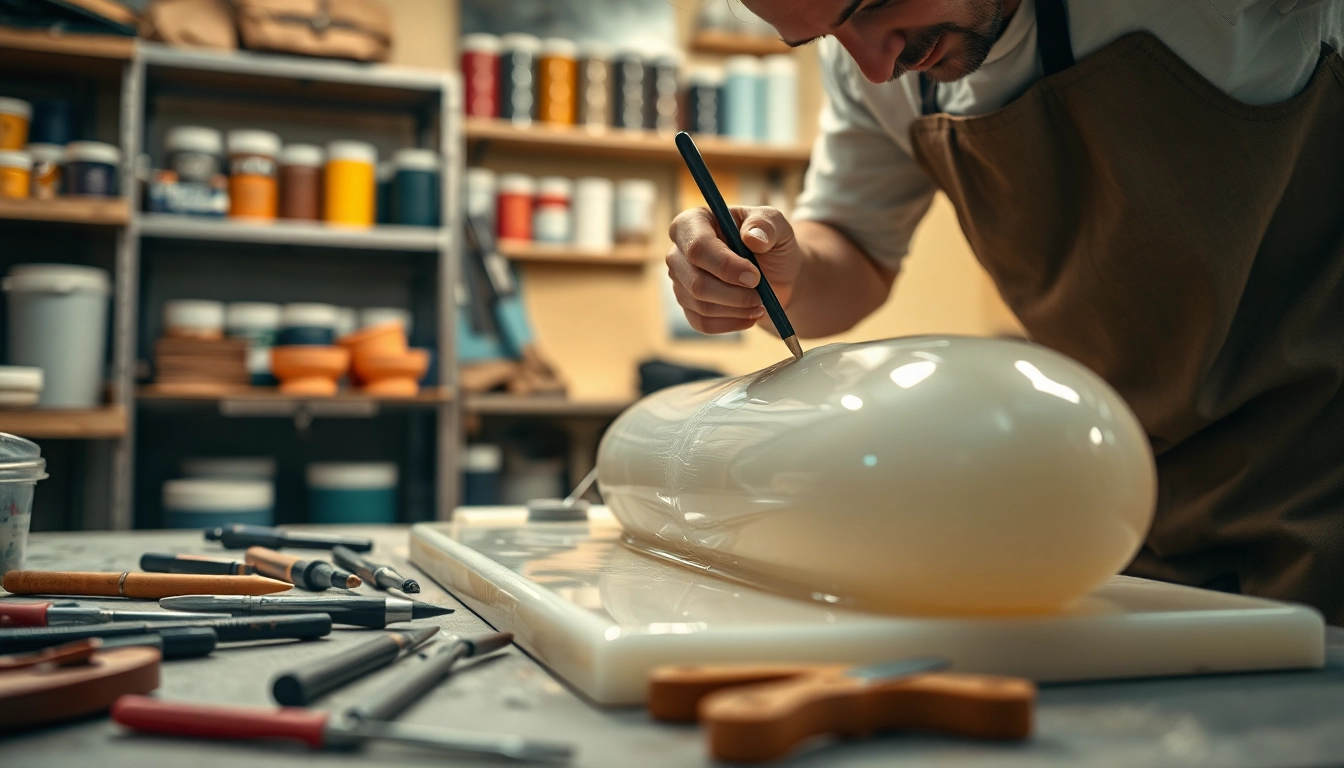Understanding Laminating Resin
What is Laminating Resin?
Laminating resin is a specialized type of resin specifically formulated for bonding layers of materials together, typically in composite structures where fiberglass or other reinforcements are employed. Its main function is to create a strong bond that is durable, lightweight, and capable of withstanding environmental stresses. These properties make laminating resin indispensable in industries such as marine, automotive, aerospace, and construction.
This resin is essential for achieving high strength and rigidity in composite materials, and it differs from other types of resins, such as gel coats or fill materials, in its primary use for layering rather than coating or filling. For anyone involved in material crafting, understanding laminating resin’s capabilities allows for better decision-making in projects requiring strong, resilient, and lasting materials. More details on the different varieties can be found in detailed resources on laminating resin.
Types of Laminating Resin
Laminating resins primarily fall into two categories: epoxy and polyester. Each type has distinct characteristics that make them suitable for specific applications.
Epoxy Laminating Resin
Epoxy laminating resin is known for its superior adhesion properties and chemical resistance. It is highly versatile and provides a high strength-to-weight ratio, making it ideal for aerospace and high-performance automotive applications. Epoxy can bond well to various materials, including metals, wood, and other composites. Additionally, it exhibits minimal shrinkage during curing, which contributes to a stable structure.
Polyester Laminating Resin
Polyester laminating resin, on the other hand, is often more cost-effective and easier to work with, making it popular in marine applications and for producing large, low-cost molds and parts. This resin typically cures faster than epoxy but is less resistant to environmental degradation over long periods. Implementations such as boat hulls and recreational vehicle bodies frequently utilize polyester laminating resin due to its suitability for large surface areas and relatively low cost.
Common Uses and Applications
The applications for laminating resin span a wide range of industries. In marine contexts, it is used to create hulls and other structures that require waterproofing and durability. The automotive industry employs laminating resin in vehicle body parts where strength and weight savings are crucial. Additionally, construction utilizes these resins for reinforcing structures and creating durable molds for casting concrete and other materials.
Recent advancements in composite technology have also facilitated the use of laminating resin in wind turbine production, where its lightweight and strong characteristics significantly enhance efficiency and performance. Versatility is a trademark of laminating resin, with uses extending to consumer products, sporting goods, and even decorative applications.
Key Properties of Laminating Resin
Adhesion and Bonding Strength
The primary focus of any laminating resin is its ability to adhere and bond effectively to a variety of substrates. This bonding strength is critical, as it determines the overall durability and performance of the composites produced. Laminating resins achieve their bonding through a variety of mechanisms, including chemical adhesion and mechanical interlocking.
Viscosity and Workability
Laminating resin is available in varying viscosities to suit different application methods. Higher viscosity resins can be easier to control during application, especially in vertical layouts. Conversely, lower viscosity resins allow for better wet-out of fiberglass layers, important for critical applications where strength and stress distribution are necessary.
Workability also includes pot life, which refers to the usable time window after the resin is mixed with the hardener before it begins to cure. This aspect is essential for multi-layer applications and intricate designs where manipulation multiple layers is needed within a limited timeframe.
Curing Time and Temperature Effects
The curing process of laminating resins is influenced heavily by temperature and the resin formulation itself. Temperature affects the rate of chemical reactions in the curing process; thus, it is vital to handle the resin within recommended settings. As a general rule, a warmer environment speeds up curing, while a cooler environment extends it.
Understanding the specific curing temperatures and times ensures a quality finish, maximizing the effectiveness of the laminated composite created. Engaging in controlled temperature environments during application often results in higher adhesion strength and less chance of defects during the laminate formation.
Choosing the Right Laminating Resin
Factors to Consider
When selecting a laminating resin, several factors must be taken into consideration. Key factors include the type of materials being bonded, desired mechanical properties, environmental exposure, and operational conditions the laminated material will face after completion. Understanding the specific needs of the application informs whether epoxy or polyester laminating resin is the better choice.
Comparative Analysis of Resin Types
Comparative analysis of epoxy vs. polyester laminating resin primarily centers around performance and cost. Epoxy generally provides greater strength and durability but comes at a higher price point than polyester. Polyester is preferable for budget-conscious applications where high strength is not critical, while epoxy is favored in applications requiring superior bonding and resistance characteristics.
How to Source Quality Laminating Resin
Quality sourcing of laminating resin can significantly impact the final outcomes of any project. Look for reputable suppliers that provide clear specifications and details about their materials. Engaging with suppliers that offer samples, technical data sheets, and support can further assist in making an informed choice. Always verify product consistency and performance characteristics from trusted industry sources.
Application Techniques for Laminating Resin
Preparation of Surfaces
Before applying laminating resin, thorough surface preparation is crucial. This process includes cleaning, sanding, and ensuring that surfaces are free from dust, grease, and moisture. By enhancing the bonding surface, the effectiveness of the resin is maximized, leading to stronger, more reliable laminates.
Mixing and Application Process
Proper mixing of laminating resin is vital for optimal performance. Typically, this involves combining the resin with hardeners and, sometimes, fillers. Following the manufacturer’s instructions for ratios is critical, as deviations can lead to incomplete curing or poor performance. The application can be achieved using various methods such as brush, roller, or spray techniques, depending on the specific project requirements and type of resin selected.
Finishing and Post-Application Care
Once the laminating resin is applied and cured, the finishing process may include sanding and the application of additional layers or coatings as needed. Post-application care includes allowing adequate curing time and monitoring environmental conditions to ensure optimal results. Maintaining cleanliness and checking for any defects will help ensure the finished product meets the desired quality standards.
Best Practices and Troubleshooting
Avoiding Common Mistakes
When working with laminating resin, several common mistakes can hinder project success, including incorrect mixing ratios, inadequate surface preparation, and neglecting temperature considerations. Avoiding these pitfalls requires careful planning, awareness of the environment, and adherence to best practices established in the industry.
Performance Metrics and Evaluation
Establishing performance metrics to evaluate the effectiveness of laminating resin applications involves understanding tensile strength, adhesion quality, and environmental resistance. Testing under controlled conditions can provide essential feedback on the materials and application process. This information can then be utilized for future projects to enhance effectiveness and quality.
Storing and Handling Laminating Resin
Lastly, proper storage of laminating resin is crucial for maintaining its effectiveness. Resins should be kept in cool, dry environments away from direct sunlight and heat sources. Containers should remain sealed to prevent moisture ingress, which can affect the resin’s curing abilities. Familiarity with the product’s shelf life and handling instructions is essential for prolonging its usability.



